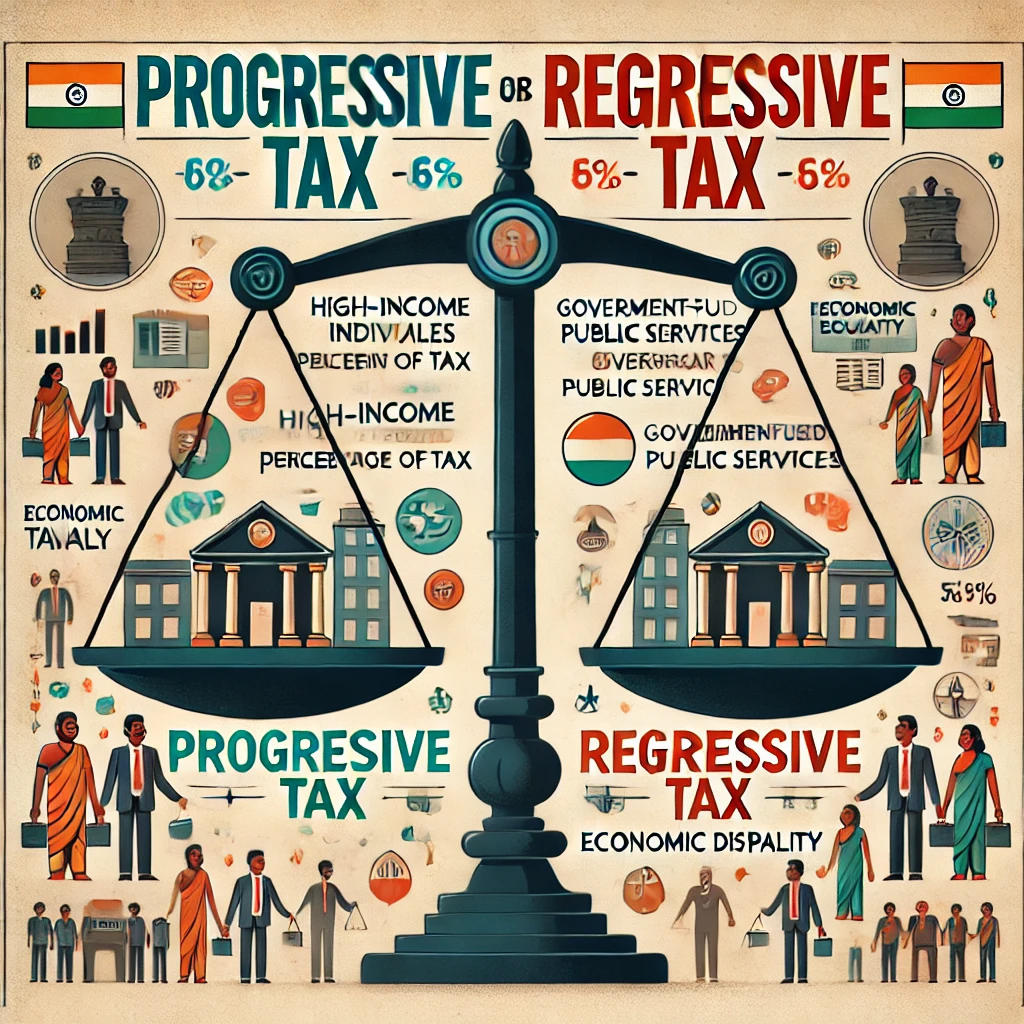Taxes are crucial for maintaining a nation’s infrastructure and public services, including healthcare, education, and welfare programs. While taxes are necessary for economic development, the manner in which they are applied can significantly affect society. In India, both progressive and regressive tax structures are in place, each with distinct impacts on income distribution and the broader economy. Understanding the differences between these systems can help evaluate their effects on society’s wealth gap and overall economic health.
What is a Progressive Tax System?
A progressive tax system is structured such that the tax rate rises as an individual’s income increases. Essentially, this means those with higher incomes pay a larger portion of their earnings in taxes. The purpose of this system is to ensure that those who have more financial means contribute more to funding government services, thus helping reduce income inequality.
In India, Income Tax is an example of a progressive tax:
- Income Tax Slabs: For the fiscal year 2024-2025, individuals earning up to ₹2.5 lakh per year are not required to pay taxes. However, those with annual earnings above ₹10 lakh are taxed at a rate of 30%, with several exemptions for lower-income individuals to reduce their burden.
- Capital Gains Tax: This tax is imposed on the profits made from selling assets such as real estate or stocks. The rate varies depending on whether the asset was held short-term or long-term, with short-term capital gains taxed at a higher rate.
- Other Wealth Taxes: Although estate duties were abolished in India, other wealth-related taxes have been discussed as methods for wealth redistribution in the past.
Benefits of the Progressive Tax System:
- Fair Contribution: Individuals who earn more contribute a larger share of their income, reducing the financial burden on lower-income citizens.
- Reduces Income Gaps: By taxing wealthier individuals at a higher rate, progressive taxes work to minimize the wealth gap, ensuring that disadvantaged groups are not overtaxed.
- Funds Social Programs: The increased revenue from progressive taxes is vital for funding essential public services like education, healthcare, and social welfare.
Challenges of the Progressive Tax System:
- Possible Negative Effect on Investment: Higher taxes on the wealthy might discourage individuals and businesses from investing or expanding, which could affect overall economic growth.
- Complex Structure: The system involves numerous tax brackets, exemptions, and deductions, which can be difficult to navigate, potentially leading to confusion or tax avoidance.
- Capital Flight: In extreme cases, high-income individuals or corporations may relocate to countries with lower tax rates, leading to a loss of revenue for the Indian government.
What is a Regressive Tax System?
On the other hand, a regressive tax system applies the same tax rate to all individuals, regardless of their income. As a result, individuals with lower incomes end up paying a higher proportion of their earnings in taxes compared to wealthier people. Though regressive taxes are easier to collect, they often have a more significant impact on those with limited financial resources, thus contributing to growing income inequality.
In India, the Goods and Services Tax (GST) serves as an example of a regressive tax:
- GST: GST is levied uniformly on most goods and services, meaning both low-income earners and high-income earners pay the same rate. This creates a larger burden for lower-income individuals, as they spend a greater portion of their income on taxable products and services.
- Excise Duties: Taxes on items such as alcohol, tobacco, and fuel are also regressive, as they are imposed uniformly, irrespective of an individual’s income level.
- Vehicle Taxes: Vehicle purchase taxes are another example of a regressive tax in India, as individuals of all income levels pay the same rates when buying vehicles.
Benefits of the Regressive Tax System:
- Simplicity: Regressive taxes are easy to implement because they apply a single tax rate across all income levels, making them easier to collect and enforce.
- Stable Revenue: Since the tax rate is the same for everyone, regressive taxes provide consistent revenue, which is easier to predict and manage.
- Encourages Spending: Taxes like GST can stimulate consumer spending, which can, in turn, promote economic growth by increasing demand for goods and services.
Challenges of the Regressive Tax System:
- Increases Inequality: Since lower-income individuals pay a higher percentage of their earnings in taxes, regressive taxes can increase wealth disparity and worsen social inequality.
- Financial Burden on the Poor: For individuals with limited incomes, regressive taxes can heighten the cost of living. This means they have less disposable income for essential goods and services.
- Limited Social Welfare Impact: Although regressive taxes provide a steady revenue stream, they are not designed to address income inequality or support the most vulnerable sections of society, limiting their effectiveness in promoting social welfare.
Conclusion: Finding Balance in India’s Tax System
The decision to adopt a progressive or regressive tax system depends on the nation’s goals and economic philosophy. In India, the progressive tax system plays an essential role in addressing income disparities, ensuring that those with greater financial resources contribute more to public revenue, which is then used to fund essential services for the poor. However, its complexity and the risk of discouraging investment are potential drawbacks.
On the other hand, regressive taxes are easier to implement and provide predictable revenue, but they disproportionately burden the lower-income population, which exacerbates social inequality. In India, both systems are used to balance efficiency and fairness—progressive taxes like income tax help redistribute wealth, while regressive taxes like GST contribute to stable government revenue.
Ultimately, a balanced approach to taxation is crucial. The system should encourage growth while addressing economic inequality and ensuring that funds are available for social programs. By striking this balance, India can create a more inclusive and sustainable economy that benefits all citizens, regardless of income.
By…
Jyotsana Sigar, 4th Year B.A LLB Lovely Professional University




